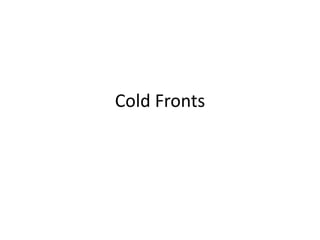
Cold fronts
- 1. Cold Fronts
- 2. Cold Fronts • When cold, continental polar air advances into a region that is occupied by warmer air, this condition results in a cold front. • As it happens with warm fronts, the area of the cold front (and warm front) nearest the ground moves more slowly due to friction as compared to the air that is aloft. • Thus, the cold front steepens as it moves.
- 3. Cold Fronts • On average, cold fronts are about twice as steep as warm fronts. • In addition, cold fronts advance at speeds of 20 to 35 miles per hour compared to 15 to 20 miles per hour with warm fronts. • These two differences, steepness and rate of movement account for the more violent nature of cold fronts.
- 4. Cold Fronts • The arrival of cold fronts is sometimes preceded by alto-cumulus clouds. • As the front advances, mainly from the west and northwest, towering clouds can often be seen in the distance. • Close to the front, a band of dark, ominous clouds foretells the ensuing weather.
- 5. Cold Fronts • The forceful lifting of warm, moist air along the cold front is often so rapid that the released latent heat increases the air’s buoyancy. • Heavy downpours and vigorous wind gusts that are associated with mature cumulonimbus clouds frequently result.
- 6. Cold Fronts • Because a cold front produces roughly the same amount of lifting as a warm front but over a shorter distance, the precipitation intensity is greater, but of shorter duration. • Marked temperature drop and windshift from the southwest to the northwest usually accompanies the front’s passing.
- 7. Cold Fronts • The sharp temperature contrast and sometimes violent weather along cold fronts are symbolized on a weather map by a blue line with blue triangular points extending into the warm air mass.
- 8. Cold Fronts
- 9. Cold Fronts • Most often, the weather behind a cold front is dominated by subsiding air within a continental polar air mass. • Thus, the drop in temperature is accompanied by clearing that begins soon after the front passes. • Although the effect is a fair amount of cooling of air aloft, the effect near ground level is relatively minor.
- 10. Cold Fronts • In winter, the long, cloudless nights that follow the passage of a cold front result in radiation cooling that reduces surfaces temperatures. • When a cold front moves over a relatively warm surface, radiation emitted from the Earth can heat the lower atmosphere enough to produce shallow convection. • This can result in low cumulus or stratocumulus clouds behind the front.